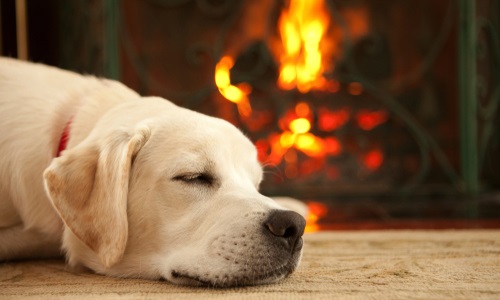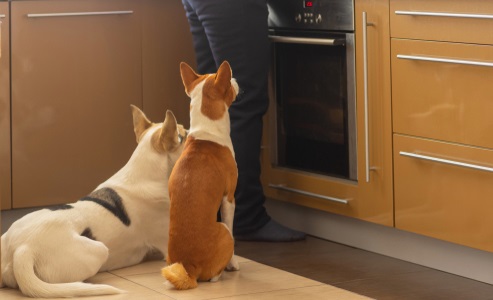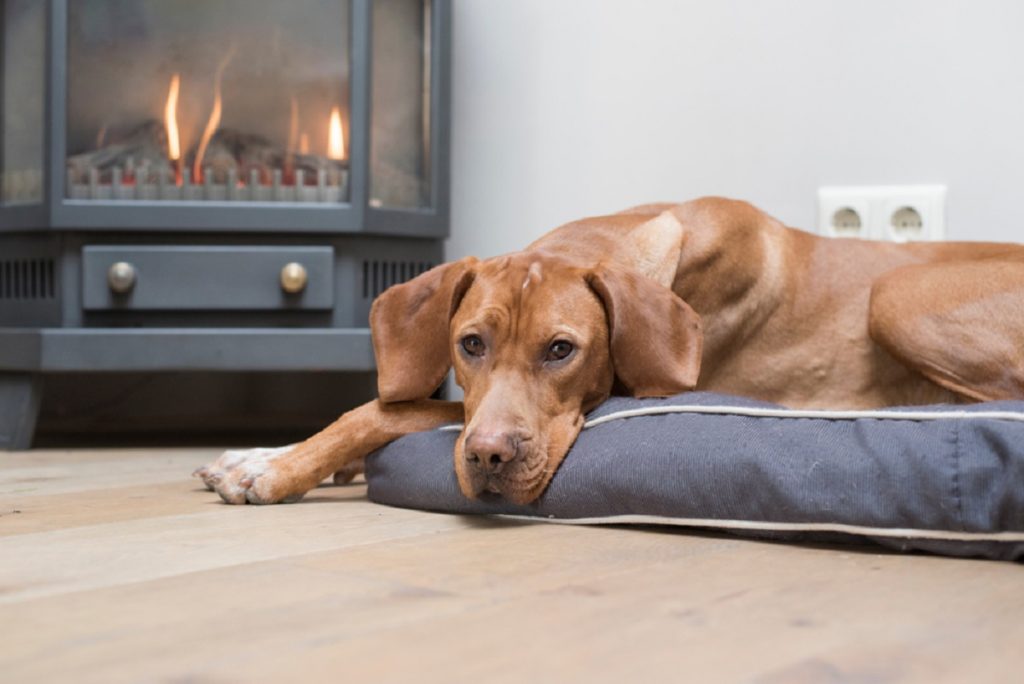If you have a dog at home, you know how much he likes to try and help you in the kitchen while you’re preparing dinner. While this attention is sweet, occasionally it can lead to hot foods or liquids spilling onto your furry best friend. Unfortunately, this isn’t the only way your pet can get burned so you need to be prepared to protect your animal but also be able to identify and treat a burn should one occur.
Causes of Burns on Dogs
The home can be a scary place for your dog as an assortment of everyday items can cause burns. Dog burns can be caused by electrical outlets, flames from your fireplace or oven, hot engine parts and appliances such as hair straighteners or curlers. More serious burns are generally caused by chemicals, cooking accidents with burning oil and boiling water or from space heaters and radiators.
Chewing on electrical cords can be one of the most dangerous causes of burns. In these cases, the dog can even be electrocuted so you must take extreme caution in these situations.
Dogs can get sunburned by falling asleep in the sun for too long or walking at the brightest times of the day or when UV rays are at their strongest. Every burn is different, and the severity can range significantly. Knowing what to look for, how to treat burns and when to take your animal to the veterinarian can save your dog from serious pain and long-term damage.
Types of Burns and Scalds
Chemical Burns: battery acid or something similar coming into contact with your dog’s skin or mouth can result in painful burns.
Radiation Burns: Solar (sun) burns or from the microwave.
Electrical Burns: Very common – caused by chewing on electrical wires or any exposure to a high electrical current.
Thermal Burns: Also very common – caused by fire, heating pads or blankets, radiators or space heaters, hot car parts, tools and grills touching your dog’s skin. Even hot foods or liquids can lead to a painful sore. In cases of thermal burns caused by fire, also be on the look out for internal and lung damage caused by smoke inhalation as symptoms may not show for up to 24 hours after the initial incident.
Scalds: Caused by hot steam or liquid coming into contact with the dog’s skin possibly from a steamer, hot iron or steam from boiling water.
What are the Symptoms of Dog Burns and Scalds?
Depending on the type of burn, dogs can suffer from a wide range of symptoms:
- Blisters
- Red and blotchy skin
- Skin ulcers
- Cracked or dry skin
- Blackened skin
- Oozing from a patch of skin or moist skin
- Red spot directly where the dog was burned
- Fur that is singed or curled
- Lesions on top of the dog’s head
- Burns on the roof of your dog’s mouth and lips
- A buildup of fluid under the skin or swelling with puss underneath
- Fur color or appearance changes
- Scratching, whimpering, crying or avoidance of touch or interaction
- In the case of sunburn – dog fevers are a good indication.
- Some breeds are much more susceptible to sunburns and eventually skin cancer so if your dog is hairless, white or thin haired, limiting and monitoring your dog’s time in the sun is crucial to his survival.
Much like human beings, dogs can get a first-, second- or third-degree burn. Depending on the level of burn, he may be able to be treated at home or may need the help of a professional veterinarian.
First-Degree Burns
First-degree burns come from chemical burns, electrical burns or scalds and leave the burned skin still on the dog’s body. Since first-degree burns are mostly superficial, barring some chemical burns, you will most likely be able to treat your dog at home. Although it is never a good idea to put ointment or cream onto your dog’s skin without a professional recommendation, there are ways you can help your dog.
 Rinsing the burn with cold water, even placing your dog in a bath or shower, can treat first-degree scalds. Then, chill the area with a cold compress or ice pack and cover the wound with a bandage so the dog cannot inflame the area further by licking or rubbing.
Rinsing the burn with cold water, even placing your dog in a bath or shower, can treat first-degree scalds. Then, chill the area with a cold compress or ice pack and cover the wound with a bandage so the dog cannot inflame the area further by licking or rubbing.
First-degree chemical burns can be a little trickier. In some cases, flushing the wound with water can make the burn worse. The best thing to do is wear gloves in order to protect yourself from the chemicals and wash the burn area with baking soda, vinegar or a mild shampoo depending on the type of chemical that burned your dog. If adding water seems to be making your dog worse or upset, call your veterinarian immediately. After the burn is free of chemicals, cover the injury with a non-stick bandage.
First-degree electrical burns must be treated with extreme care and you should make sure there are no exposed wires on or around the dog before attending to the injuries. Once the power is off and the area is cleared, treat this burn similarly to a scald – rinsing it with water, applying a cold compress and covering the burn with a bandage.
After initial treatment, always call your veterinarian for further treatment information.
Second- and Third-Degree Burns in Dogs
When the lesion is larger, skin is burned off or completely through to exposed tissue, you must act quickly. In these serious cases, it is always wise to take your dog to a veterinarian or even an emergency hospital. Serious burns can cause infection, renal failure in the kidneys and even shock. These are serious side effects that can lead to death if not properly treated. After taking your dog to a clinic, the veterinarian will typically cut away infected or dead skin, treat the burn with saline and prescribe antibiotics to prevent infection and opiates for pain management.
Third-degree burns can be serious and life threatening and can lead to serious charring where deep flesh is visible. In these situations, your dog will need intravenous fluids and electrolytes to ensure proper organ function. Depending on the severity and size of the burn, your veterinarian may want to keep your dog overnight for observation to confirm he will not go into shock and to keep him sedated to ensure less pain and movement so the burn heals correctly.
While in the hospital, your veterinarian will monitor urine output, fluid and food input and continue doing blood testing to ensure your dog doesn’t have complications with anemia. Canine anemia can cause destruction in his blood and will require a transfusion. Serious canine bacterial infection can also occur when the burn covers large portions of your dog’s body. In the off chance your dog has inhaled smoke from a fire, the veterinarian will also monitor lung issues and will take chest X-rays to ensure proper lung function. Once your dog has been cleared of all complications and the burns have been treated properly, he will be ready to transition to home care.
How to Care for Your Dog During Burn Recovery
Every burn is different and therefore no recovery will look exactly the same or take a similar amount of time to heal. In all cases, it is ideal to monitor the wound, make sure your dog continues to eat and drink normally to speed up the recovery time and administer any medications given to you by your veterinarian.
For first-degree and less severe burns, you’ll want to focus on making your dog as comfortable as possible and continue dressing the burn. Generally, it will take anywhere between two and four weeks for the burn to heal completely.
In the case of a more severe burn, the recovery process can be much more complicated and your dog will need much more attention. You will have to apply antibiotic ointment given to you by the veterinarian, regularly change bandages and administer antibiotics. Follow-ups with your veterinarian may be necessary if the healing doesn’t progress as expected or your dog needs more serious treatment such as skin grafts or monitoring complications from possible renal failure.
So How Do We Prevent Burns?
The best way to prevent your dog from being burned is to be conscious of you and your pup’s surroundings. Be aware that burns are a real danger but don’t be consumed by fear. There are some simple solutions to creating a safer environment for your furry friend.
 Be vigilant!
Be vigilant! - Keep all cleaning chemicals out of sight and out of your dog’s reach by putting child locks on low cabinets and keeping chemicals in high, out of reach areas
- Keep batteries in a special protected location
- Cover loose electrical cords with duct tape or remove from floor completely
- When cooking, keep your dog out of the kitchen to avoid boiling liquids and hot stoves
- When grilling outdoors, keep your dog inside until the grill has cooled completely
- Monitor the amount your dog is in the sun – take walks in the mornings and evenings and even apply sunblock to sensitive areas like the nose and belly
- Keep beauty appliances like straighteners and curlers out of reach
- After bathing, dry your dog with the hair dryer set to cool
- In extremely hot cities, put booties on your dog to avoid paw pad burns
- Keep a guard around your fireplace to ensure your dog doesn’t burn himself on the flames or get close enough to inhale smoke
- Watch your dog closely around space heaters and radiators
Summary
No home is 100% dog burn-proof and accidents happen all the time! The most important thing is to know how to prevent burns, recognizing the signs of a burn and how to react should something happen to your dog.
The four most important things are:
- Keep your home as dog safe as possible – accident prevention is the key! Hide wires, store chemicals and keep your dog away from anything so hot you wouldn’t put your bare hand on.
- Know what to look for – Pay attention to the behavior of your animal and if your dog is showing symptoms of a burn, be ready to act.
- Treat the burns accordingly – know the difference between first-, second- and third- degree burns. This will be instrumental in treating your dog with the best care possible and determining if your dog may require additional care.
- Call your veterinarian – only a doctor knows what your dog needs! When the
burn looks serious and your dog is in pain, always take him to a hospital or clinic for a professional evaluation.
If you can follow these guidelines, you’ll be prepared to care for your dog in any burn situation, and get your dog back to full health as quickly as possible.
Sources:
- Playfourth, Laura, et al. “Burns and Scalds in Dogs | Causes, Symptoms & Treatments.” Vets Now, Vets-Now.com, 4 Apr. 2019, www.vets-now.com/pet-care-advice/burns-and-scalds-in-dogs/.
- petMD. “PetMD.” PetMD, 18 Mar. 2016, www.petmd.com/dog/emergency/accidents-injuries/e_dg_burns_and_scalding.
- WagWalking. (2019). Burns and Scalds in Dogs – Symptoms, Causes, Diagnosis, Treatment, Recovery, Management, Cost. [online]. https://wagwalking.com/condition/burns-and-scalds.
- Burn Treatment for Dogs – 1800PetMeds. (n.d.). 2019. https://www.1800petmeds.com/education/burn-treatment-for-dogs.htm.




